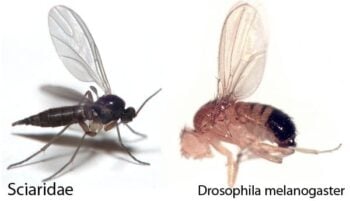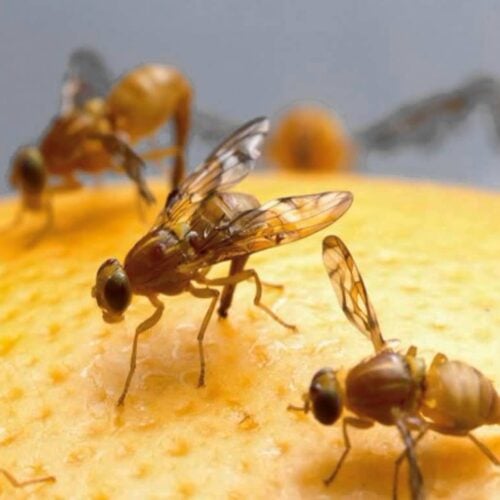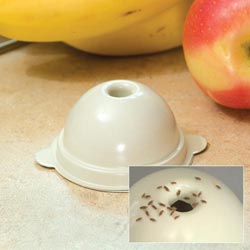If you have been seeing small flies or gnats in your kitchen, they’re probably fruit flies. In the high heat of summer, with a bounty of fresh summer produce in your kitchen, fruit flies can quickly become pesky invaders because they are attracted to ripened or fermenting fruits and vegetables.
Here’s how to get rid of fruit flies naturally and effectively.
Fruit Fly Biology

Fruit flies (Drosophila melanogaster) are also sometimes called vinegar flies. They are common in homes, restaurants, supermarkets and wherever else food is allowed to rot and ferment. Adults are about 1/8 inch long and usually have red eyes. The front portion of the body is tan and the rear portion is black.
Fruit flies are different than fungus gnats, though they look very similar to each other. While both insects eat rotting organic matter, fruit flies are specifically drawn to ripening produce and fermenting food and beverages, whereas fungus gnats prefer the rotting organic matter found in moist soil.
Fruit flies lay their eggs near the surface of fermenting foods or other moist, organic materials. Upon hatching, the tiny larvae continue to feed near the surface of the fermenting food. This means that any damaged or over-ripened portions of fruits and vegetables can be cut away and composted, and you can still eat the rest of it.
Fruit flies reproduce ridiculously fast. Given the opportunity, they will lay about 500 eggs! The entire life-cycle from egg to adult can be completed in about a week. This is why fruit flies are the darling of genetics laboratories.

Fruit flies are especially attracted to ripened fruits and vegetables in the kitchen, but they will also breed in drains, garbage disposals, empty bottles and cans, trash containers, mops and cleaning rags. All they need is a little moisture and something fermenting or moldering.
Even your moist toothbrush bristles are fodder for the fruit fly!
Fruit flies get brought into your home from fruits or vegetables at the market that were previously infested. The adults can also fly in from outside through inadequately screened windows and doors.
Fruit flies are primarily a nuisance. However, they also can carry bacteria that can contaminate your produce and cause it to ripen and rot sooner. This bacteria won’t harm you, but it will shorten the life of your expensive, organic fruits and veggies.
Preventing Fruit Flies
Good prevention strategies simply keep fruit flies out of your home and off your produce.
- Clean your produce as soon as you get home, and store it loose or in a new bag, rather than in the plastic bag you got from the store. Better yet, skip the plastic bag altogether, and carry reusable produce bags to the store with you.
- Cover your fruit bowl or store fruit in the refrigerator. Sweet fruits are their favorite attractants, and fruit flies can hasten its spoilage.
- Don’t put food or beverage containers in waste paper baskets. Always take them to a kitchen can, compost or recycling bin.
- Use, freeze or compost all overripe fruits and vegetables.
- Don’t keep any vegetable or meat scraps in your garbage can inside your home. Place your vegetable scraps in a bag or freezer bag and put them in the freezer. You should either make soup out of them, bury them in a compost pile, or keep them frozen in a sealed bag, and throw them away in an outside garbage can.
- Take out your compost. Any scraps or leftovers you plan to compost you should take out right away. If you can’t get them out right away, put them in a bag in the freezer until you can. Make sure your compost pile is situated far from your home and that you bury your food scraps in the pile.
- Wash all dishes and clear the drains in your sink. You can also pour baking soda followed by white vinegar into your drains to kill any fruit flies that may be breeding there.
- Don’t leave wet dishrags in the sink.
- Clean the seals of your refrigerator door, the top and under the fridge. You should especially clean the evaporation pan if it has one.
- Clean under and around your dishwasher and stove. Food residue and crumbs are great fodder for more than fruit flies.
- Allow the first inch of the soil in your houseplants to dry out before watering. Remove any dead leaves from the pot as they fall.
- Make sure you have good window and door screens. Keep these pests from flying in and taking up residence!
Physical Controls
In addition to removing their food sources and preventing them from getting in, the best way to get rid of fruit flies is to use a trap.

Fruit Fly Trap Recipe
Equipment
- Pint canning jar (16 oz.) with metal lid if possible
- hammer and standard nail OR ice pick OR plastic wrap, rubber band and a fork/skewer/toothpick
Ingredients
- 1/2 cup apple cider vinegar, OR wine, stale beer or bourbon (white vinegar does not work well)
- 1 piece overripe fruit, cut open
- 2-3 drops dishwashing soap, (Rhis breaks the surface tension of the liquid, making it hard for the flies to escape.)
Instructions
- If you have the metal lid for your jar and want to make a long-lasting, spill-resistant trap, use an icepick or nail to poke 8-12 holes into the lid. You want the holes big enough for a fruit fly to enter, about 1/8 of an inch. (Don't worry, they are too dumb to get out of such small holes, plus the dishwashing soap will help drown them.)
- If you don’t have the lid or want to make a temporary trap, use a piece of paper or plastic wrap and a rubber band to tightly cover the top of the jar. Poke several holes into it with a fork, skewer or toothpick.
- Fill the jar with about an inch of apple cider vinegar, wine, beer or liquor. Stir in a couple drops of dishwashing soap, then place a small piece of overripe, cut fruit into the middle of the liquid. Make sure the fruit is big enough to stick out of the liquid a little.
- Place the trap (or traps) where you normally see fruit flies. Every 2-3 days, dump the contents of the jar down the drain or into the compost pile, and start again with a fresh vinegar mix.

You can also buy fruit fly traps at better garden stores as well as online. (Where to find online)
These commercial traps are non-toxic and work exceptionally well, but because fruit flies are so, well… fertile, their cost can add up if you don’t also put strong prevention measures into place too.
Using a combination of prevention and a good trap, there is no reason to suffer annoying fruit flies in your home anymore.










40 thoughts on “How to Get Rid of Fruit Flies Naturally”